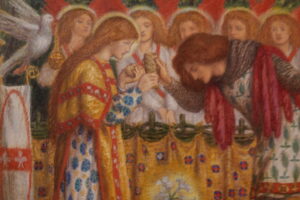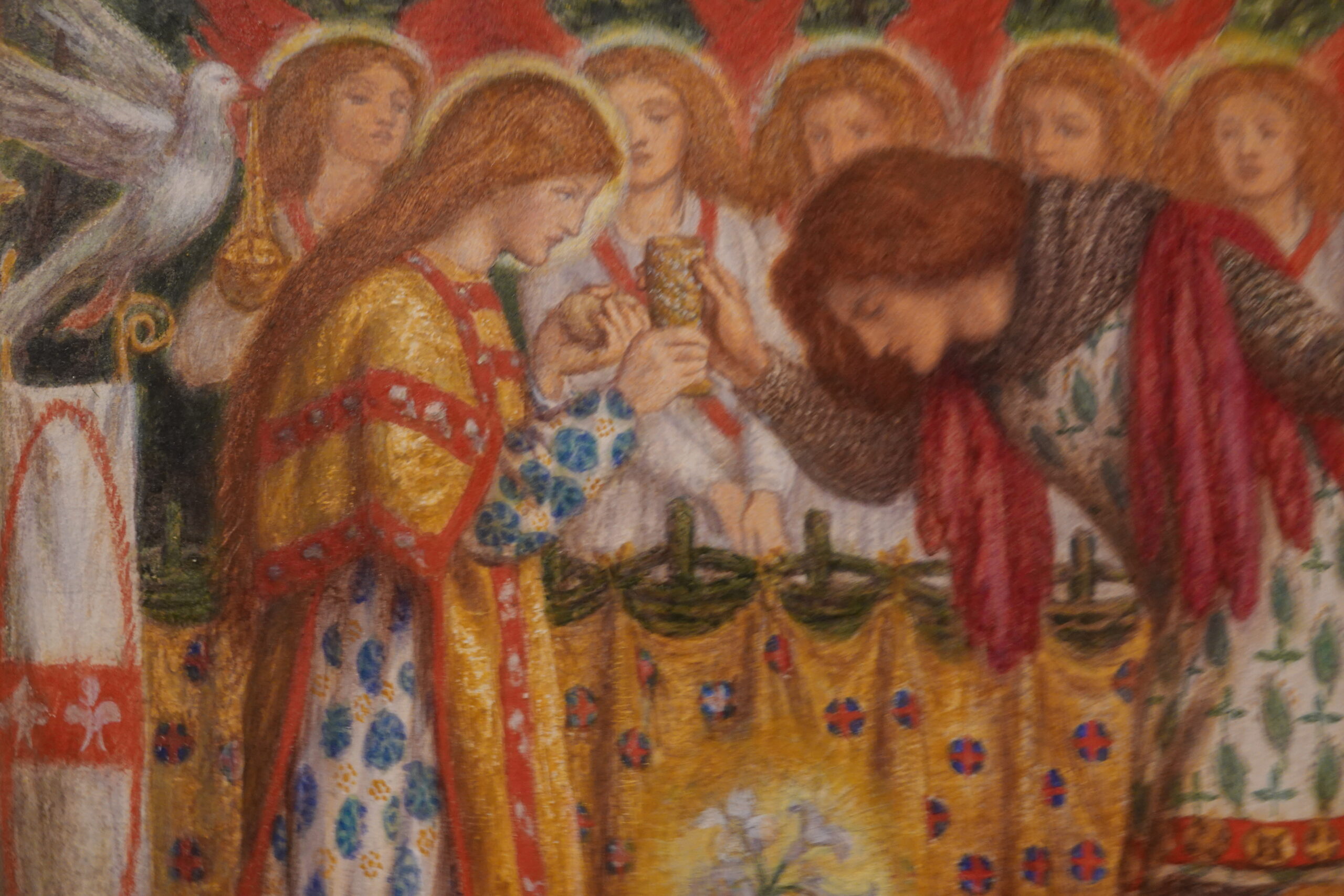Tate Britain is currently hosting an exhibit of the most extraordinary English paintings of the 19th century. It is simply entitled The Rossettis, who were four siblings: Gabriel, Christina, William and Maria. Together, they altered the trajectory of art.
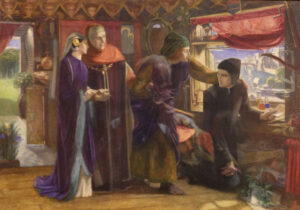
Christina is the most famous, but as her artistic expression was in poetry, she is not the most visible person here. Gabriel, who assumed the name Dante Gabriel, is really the central figure here. Surprisingly, the second spot in this exhibit is his wife of only 2 years, Elizabeth Siddal (1829-1862). Dante Gabriel depicted the real poet Dante too; shown at right is an 1853 watercolour Dante drawing an Angel on the Anniversary of Beatrice’s Death.
For those not too familiar with the Rossetti family (whose Italian origins set them apart from native English people in the Victorian era), they were key in creating the Pre-Raphaelite art movement. This was art done in the style of European painting before it was transformed by Raphael (1483-1520). A 7-member Brotherhood was formed in England in 1848; they included Dante Gabriel and his brother William, William Holman Hunt, and John Everett Millais.
In the case of Dante Gabriel, the resultant body of work effected a sea change in what people regarded as beauty. A prime example of this is the model Alexa Wilding (shown here). Women with red hair were, at the time, not considered as great beauties; Dante Gabriel changed that! The sheer power of these paintings is overwhelming, and to take it all in, this huge exhibit takes at least 2 hours. Along with the Vermeer exhibit currently on in Amsterdam (which I also saw), these are two of the most important art exhibits ever staged.
It has been 30 years since the works of Siddal have been brought together in a retrospective. Only 60 of her works are known, and for many of those we only have a photograph to record what they were. To quote from the exhibit catalog, “Her influence on Gabriel and others in the circle, evident in this exhibition, has only very recently come to light.”
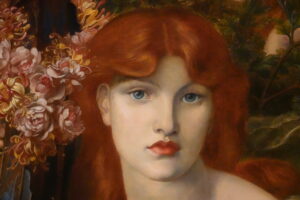
Insightful as the catalog is, it has some deficiencies. The footnotes are quite spare in their information. For example, we are told that Dante Gabriel’s maternal uncle John Polidori had written a book entitled The Vampyre, which steered Gabriel’s interest to the works of Edgar Allan Poe, and themes of the uncanny such as Goethe’s Faust. Gabriel was actually the first to illustrate Poe’s The Raven; that was in 1846. But we are not told, in the footnote, the basic fact as to when Polidori’s book was published. It was 1819, and is regarded as the first novel about vampires.
As I mentioned, Christina was a poet. (The catalog describes her poems as “flinty: sharp-edged and durable, they are meant to be used as tools or to start fires). The B&W illustrations for her books were done by Dante Gabriel, and these are on display. One of her poems was A Royal Princess, which “explores the disorienting effect of sheltering women from social realities.” It inspired a woman of another century, Florence Harrison, to create her own illustrations for a 1910 edition. The catalog says that in “shifting from black and white to colour, her illustrations convey the transformative power of the princess’s decision to face the world.” It points the reader to two illustrations in the catalog, but only one is in colour. The one in colour, reproduced full page, is quite dramatic, showing the princess in a long red dress looking down at an angry mob, some of whom hold torches of fire.
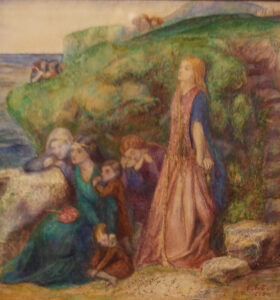
The chapter in the book on Mythbusting Elizabeth Siddal (one of 12 chapters, each written by an art expert) is provocative, but often lacks engagement with the illustrations it includes. A beautiful watercolour by Siddal, dated to 1856, is given a full page. But the text merely states “Working on a small scale, she progressed to illustrations of Border ballads, including Sir Patrick Spens, her source material being a volume that is neatly inscribed with her name.” While some readers may know what “Border ballads” refers to, I suspect very few will know the particular one she illustrated. Those fortunate enough to see the exhibit in person can read the description so sorely needed in the catalog. Sir Patrick Spens, the description states, “is a ballad which describes the shipwreck from the points of view of those drowning and those waiting on the land. Elizabeth devised individual gestures to express the women’s grief. A mother encloses her son’s face in her hands. The standing figure is a self-portrait.” The description in the exhibit also includes 4 lines of the ballad.
Another Siddal painting, Clerk Saunders (from 1857), gets even less description in this chapter. Luckily the description in the exhibit includes something remarkable: even though it had been sold to a collector, Dante Gabriel asked to have it returned to him “to add to those of hers which are now mine, and which every year teaches me to value more & more as works of genius.” He did indeed miss Elizabeth, who died at age 32. But for an even greater manifestation of A pure example of High Victorian Romanticism, consider this. When she died, Dante Gabriel “made the drastic decision to place his poetry in Elizabeth’s coffin.” Six years later, “he exhumed her coffin one night at Highgate Cemetary to retrieve his poems.” Two years after that, in 1870, he published his first poetry volume. This shocking sequence of events, the catalog states, “has permeated Pre-Raphaelite discussions,” but it goes no further in describing them.
Siddal began as a model for Dante Gabriel before marrying him, and this catalog succeeds admirably in rescuing her from the ‘silent and submissive’ type championed by men of her century. Siddal was actually “a multifaceted New Woman artist and writer who operated within a wider artistic and feminist network that was forging a communal identity much like the Brotherhood.” Crucially, she was the only woman whose art was included in an exhibition the Brotherhood staged at the first Pre-Raphaelite Exhibition of 1857. Art would never be the same after that.
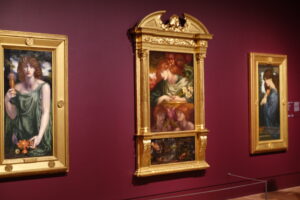 This exhibit features a very special treat. The shipping magnate Frederick Leyland made one of the rooms in his house in London a shrine to Dante Gabriel. Forming a triptych, he placed The Blessed Damozel in the centre, with Mnemosyne on its left, and Proserpine on its right. For the first time in more than a century, these three are back together. The catalog shows a 19th century photograph of the room. On an adjacent wall was another Dante Gabriel work, Veronica. All four paintings are here at the Tate Britain. The visual effect is one of the most astounding I have ever seen.
This exhibit features a very special treat. The shipping magnate Frederick Leyland made one of the rooms in his house in London a shrine to Dante Gabriel. Forming a triptych, he placed The Blessed Damozel in the centre, with Mnemosyne on its left, and Proserpine on its right. For the first time in more than a century, these three are back together. The catalog shows a 19th century photograph of the room. On an adjacent wall was another Dante Gabriel work, Veronica. All four paintings are here at the Tate Britain. The visual effect is one of the most astounding I have ever seen.
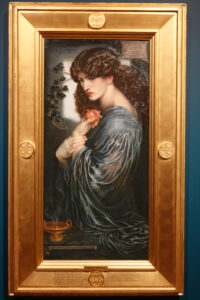 The Blessed Damozel is from a poem Dante Gabriel wrote; it was partly inspired by Poe’s The Raven. Part of the poem is on a small piece of paper he painted into the upper right, thus fully uniting poem with painting. Alexa Wilding was the model, and she was also the person used when he painted Lady Lilith and La Ghirlandata, both on display here. A detail from the latter work is shown in this review. Jane Morris was the model for both Mnemosyne and Proserpine (shown here at right). She was the wife of Dante Gabriel’s friend William Morris, but that did not prevent her from become Gabriel’s lover too.
The Blessed Damozel is from a poem Dante Gabriel wrote; it was partly inspired by Poe’s The Raven. Part of the poem is on a small piece of paper he painted into the upper right, thus fully uniting poem with painting. Alexa Wilding was the model, and she was also the person used when he painted Lady Lilith and La Ghirlandata, both on display here. A detail from the latter work is shown in this review. Jane Morris was the model for both Mnemosyne and Proserpine (shown here at right). She was the wife of Dante Gabriel’s friend William Morris, but that did not prevent her from become Gabriel’s lover too.
Dante Gabriel also reached back into English mythology to create extraordinary works. One shows the Wedding of St. George, the patron saint of England; another (detail shown in the lead photo of this review) depicts Sir Galahad, from the legend of King Arthur, and a third depicts Arthur’s Tomb.
The richness of this exhibit is breathtaking; I have touched on only a few highlights here. Any art lover planning a trip to London this summer must see this.
The Rossetti exhibit is on thru 24 Sep 2023
Visit the website for tickets and ordering the catalog of the exhibit ($60 hardcover): www.tate.org.uk
